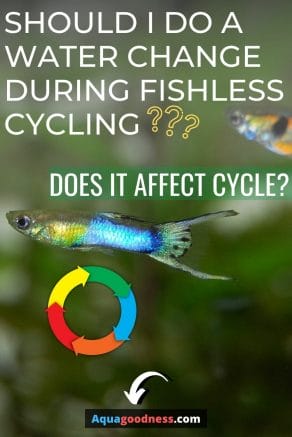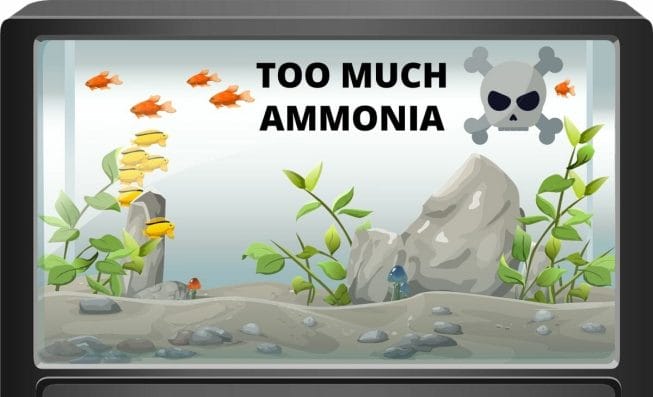If you’re a beginner I know fishless cycling can be confusing.
And one of the questions many beginners ask when it comes to fishless cycling is whether you should do a water change during fish recycling?
In this article, I’m going to answer the same question.
You need to do partial water change during fishless cycling only when the ammonia levels in your tank exceed above 4 PPM. Ammonia level above 4 PPM is toxic for the beneficial bacteria and it can stop the cycle. Doing a water change will help to reduce the concentration of ammonia in your tank.

Table of Contents
When should you do water change during fishless cycling?
There’re two scenarios when you’ll need to do a partial water change during fishless cycling
1. High ammonia level

There are two popular ammonia sources used in fishless cycling
- Pure liquid ammonia
- Fish food
Most likely, you’re using one of these as an ammonia source in your fishless cycling method.
If you’re using pure liquid ammonia as an ammonia source then you have control over how much ammonia you’re actually putting in your tank.
Ideally, your fish tank should contain ammonia between 2-4 PPM for the nitrogen cycle to proceed.
However, sometimes mistakenly you may add more drops of pure liquid ammonia in your tank which will raise the ammonia levels above 4 PPM.
Now the problem with too much ammonia (more than 4 PPM) is it is toxic for the beneficial bacteria.
And too much ammonia can stop your nitrogen cycle!
On the other hand, if you’re using fish food as an ammonia source in your fish tank then you really don’t know exactly how much fish food you’ll need to put in your fish tank to reach ammonia levels between 2 to 4 PPM.
So with the fish food, reaching and maintaining ammonia levels between 2-4 PPM is a bit trial and error process.
First of all, you’ll need to add A pinch of fish food in your tank and then wait for a couple of days. Then check the ammonia levels in your tank.
If it is between fore 2-4 PPM then it’s fine. But if the ammonia is less than 2 PPM then you’ll need to add more or fish food. And again wait for a couple of days and recheck and see if the ammonia level is more than 2 PPM and less than 4 PPM.
As you don’t know how much ammonia the fish food will produce, sometimes the ammonia levels increase to more than 4 PPM in your tank.
As I mentioned earlier, too much ammonia i.e. more than 4 PPM is toxic for the beneficial bacteria. And it can stop the nitrogen cycle.
So, in this case, you’ll need to reduce the concentration of ammonia in your tank.
And the simplest way to do it is by doing a partial water change.
How much partial water change should I do if my fish tank has high ammonia levels?
How much partial water change you should do really depends on the concentration of ammonia levels you have in your tank.
For example, if the ammonia level in your tank is 8 PPM then doing a partial water change of about 50% of the tank water can reduce the ammonia level as low as 4 PPM.
Do Aquarium Plants Absorb Ammonia?
2. Low PH

The second scenario where you’ll need to do a partial water change is when your fish tank water contains pH lower than 7 PPM.
For the beneficial bacteria to grow in your fish tank, the water of your fish tank should have pH of at least 7 or above.
So you’ll need to test the water of your tank and make sure that it doesn’t have pH lower than 7.
If you noticed the pH is below 7 then the simplest and the easiest way to increase the pH of the water is to do a partial water change of about 20%.
52 Best Freshwater Aquarium Plants For Beginners (And Care Guide)
Will doing a partial water change affect the nitrogen cycle?
There is a common myth that beneficial bacteria live in the water of your aquarium.
And the reality is it doesn’t! The beneficial bacteria don’t live in the water of your aquarium. Instead, it lives on all the surfaces in your aquarium like the glass walls of the aquarium, ornaments, etc.
So, doing a partial water change during your fishless cycling will not affect the nitrogen cycle.
15 Mistakes Beginners Make with their Goldfish Tank (How to avoid them)
FAQ
How long does it take to cycle a fishless tank?
It takes anywhere between 4 to 6 weeks to cycle a fishless tank.
I have written a detailed article covering this topic. And I have also shared tips to speed up the cycling. You can check out the article here.
Do I Need Soil for Aquarium Plants?
How can I speed up my fishless cycle?
It is going to take a while to complete a fishless cycle.
To speed up the cycling process you’ll need to add the beneficial bacteria in your tank. Doing so will instantly cycle your tank.
1. Add beneficial bacteria bottle
You can add a bottle of beneficial bacteria in your tank.
there are several brands that sell live beneficial bacteria in small bottles.
Here are my recommendations:
- Dr.Tim’s Aquatics Freshwater One & Only Nitrifying Bacteria- See its reviews at Amazon here
- Fritz Aquatics FritzZyme 7 Nitrifying Bacteria for Fresh Water Aquariums- See its reviews at Amazon here
2. Filter or filter media from an established/cycled tank
You can add the beneficial bacteria in your tank by adding a filter or filter media from an established tank i.e. the tank which is already cycled and has a lot of beneficial bacteria in your new tank setup.
It is the fastest way of cycling your fish tank.
Obviously, the above method will work for you if you already have an established tank. Or you can get the filter or a filter media from an established tank from your friend or your local fish store.
One thing to keep in mind if you’re going to add a filter or filter media from an established tank is that when you add the filter of filter media you’re not only adding the beneficial bacteria but you may also be introducing harmful disease-causing bacteria and viruses in your tank if the established tank has those bacteria and viruses.
3. Focus on basics
Besides the methods mentioned above, focusing on the basics and creating and maintaining an ideal environment in your fish tank for beneficial bacteria is a way to speed up the fishless nitrogen cycle.
- Dechlorinate the water
You should always dechlorinate the water before adding it in your tank because chlorine is toxic to beneficial bacteria.
So if your fish tank water contains chlorine then the beneficial bacteria will not form in your tank.
You can easily dechlorinate water using a dechlorinating agent like Seachem prime. Check it out at Amazon here.
- Maintain pH of 7 or above
As I mentioned earlier, beneficial bacteria require a pH of the water of at least 7 PPM or above. So you should regularly test the water of your tank and if you noticed pH below 7 then doing a partial water change can help to increase the pH.
- Increase oxygen in your tank
Beneficial bacteria are living organisms. So just as other living things, beneficial bacteria also require oxygen to survive.
Increasing oxygen in your fish tank can help beneficial bacteria to grow and thrive in your tank.
So you should increase the oxygen levels in your tank to increase beneficial bacteria in your tank.
You can easily increase the oxygen levels in your tank by adding an air pump in your tank
I recommend Tetra whisper air pump. It is a very reliable and quiet air pump.
You can check its review and latest price at Amazon here.
- Never shut down the filter
Your aquarium filter is a great place for beneficial bacteria to form their colonies.
As mentioned above, beneficial bacteria require dissolved oxygen to survive and thrive.
That’s why you should never shut down your filter!
If you do shut down the filter then the filter will not have a continuous water flow. So the beneficial bacteria in the filter will not get dissolved oxygen and eventually they will die.
Do I Need to Cycle My Tank Before Adding Live Plants?
How do I know if my tank is cycled?
When you start noticing 0 ammonia levels, 0 nitrate levels, and some nitrate level in your tank then you can conclude that your fish tank is cycled.
By this time, your fish tank contains enough nitrifying bacteria to convert ammonia into nitrate and nitrite into nitrates.
20 Tips to Maintain a Healthy Aquarium
Conclusion
There could be a couple of scenarios when you’ll need to do a partial water change even during fishless cycling.
The first is when you noticed a very high ammonia level i.e. more than 4 PPM.
Doing a partial water change will help to reduce the concentration of the ammonia
And the second is when you noticed that the pH of the water in your tank is lower than 7 PPM.
In this case, doing a partial water change will help to increase the pH of the water.
I hope you found this article helpful.
If you do, please share it.
Good luck with your fishless cycle!
Related articles:
pH is not measured in PPM it is percent hydrogen ions. It is based on a scale from 0 to 14.
Fixed it! Thanks for the info.